Let’s face it – instant coffee gets a bad rap. While it’ll never fully replace your favorite coffee shop brew, we’ve discovered some game-changing tricks that can transform your basic instant coffee into something surprisingly delicious.
The secret isn’t in expensive brands or fancy equipment. We’re talking about simple techniques using ingredients you probably already have in your kitchen. From adjusting your water temperature to adding unexpected flavor enhancers, these methods can elevate your instant coffee from “meh” to “wow” in minutes.
Whether you’re dealing with early morning rushes, office coffee breaks, or camping trips, knowing how to make instant coffee taste better will save your day (and your taste buds). We’ll share our tried-and-tested methods that’ll have you reaching for that instant coffee jar with confidence instead of resignation.
Understanding Instant Coffee Basics
Before we jump into improvement techniques, we need to grasp why instant coffee tastes the way it does. This knowledge helps us target the right answers for better flavor.
What Makes Instant Coffee Different
Instant coffee undergoes a dramatically different manufacturing process than ground coffee. Manufacturers brew large batches of coffee then extract all moisture through freeze-drying or spray-drying methods. This process removes volatile compounds that create the complex flavors we associate with fresh coffee.
The freeze-drying method preserves more flavor compounds by freezing brewed coffee into ice crystals then removing moisture through sublimation. Spray-drying shoots hot brewed coffee through heated chambers where water evaporates instantly leaving behind coffee powder.
Both methods result in coffee crystals that dissolve quickly in hot water but lack the oils and aromatic compounds found in freshly ground beans. The convenience comes at the cost of flavor depth and complexity.
Common Instant Coffee Problems
We encounter several consistent issues with instant coffee that affect taste quality. The most prominent problem is bitterness caused by over-extraction during the manufacturing process and improper water temperature during preparation.
Weak or watery flavor represents another frequent complaint. This happens when manufacturers prioritize shelf stability over flavor concentration. Many instant coffees contain fewer coffee solids per serving compared to ground coffee.
Artificial or chemical tastes often develop from processing methods and added preservatives. Some brands include anti-caking agents or flavor enhancers that create off-putting tastes.
Temperature sensitivity creates additional challenges. Instant coffee becomes more bitter when prepared with boiling water yet tastes flat when water temperature drops too low. We need to find the optimal brewing temperature for each exact brand.
Stale or oxidized flavors emerge from prolonged storage or exposure to air and moisture. Instant coffee loses volatile compounds over time even in sealed containers.
Essential Equipment and Tools
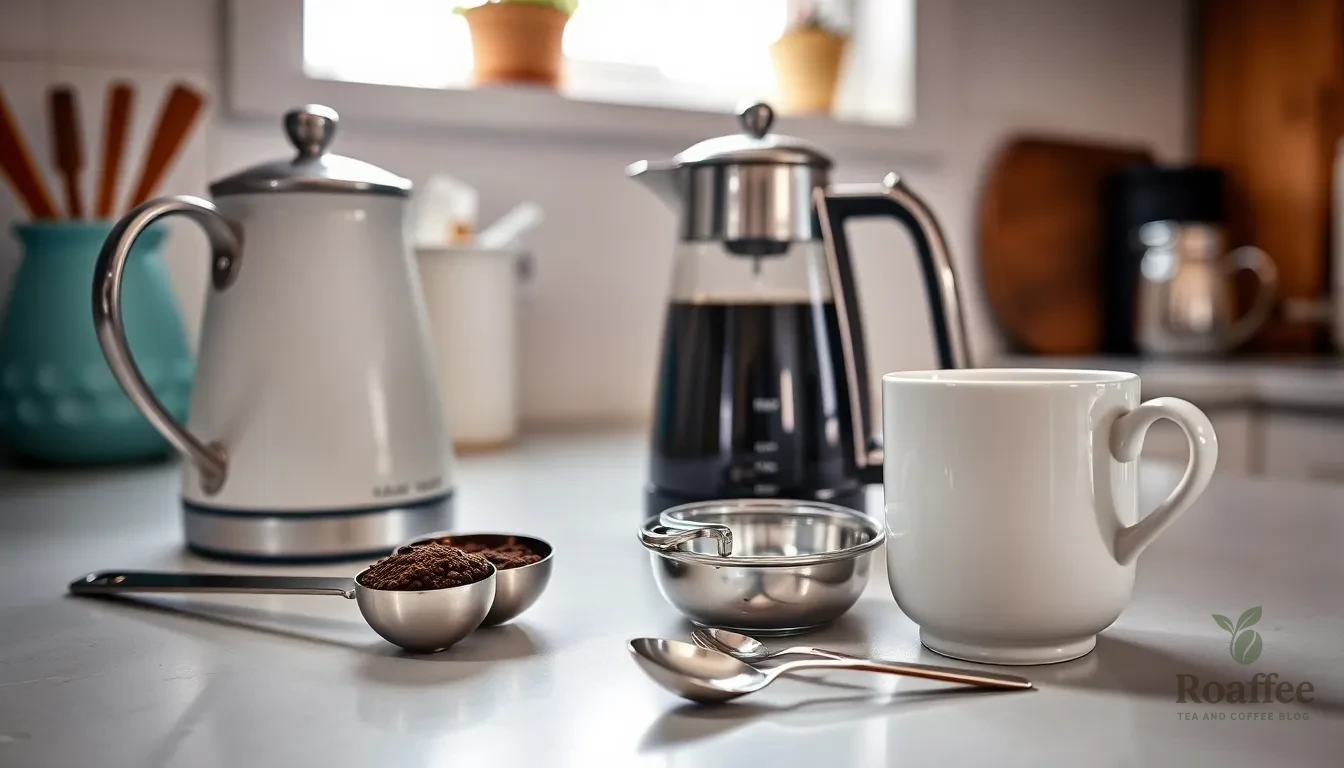
The good news is that transforming your instant coffee doesn’t require expensive gadgets or professional equipment. We’ll show you exactly what basic tools you need plus some optional items that can take your coffee to the next level.
Basic Coffee Making Equipment
Kettle: We recommend using a kettle to boil fresh filtered water every time. Avoid reboiled or stale water since it introduces off-flavors that can make your coffee taste flat or metallic.
Measuring spoons: These help you control the exact amount of coffee granules for better flavor balance. Precision matters when you’re working with instant coffee since too little creates weak coffee while too much results in overwhelming bitterness.
Cup or mug: Any standard coffee cup or mug works perfectly for brewing and serving your enhanced instant coffee.
Optional Flavor Enhancement Tools
Milk frother: This tool adds a cafe-style creamy texture by frothing milk or cream to top your coffee. The frothed milk creates a luxurious mouthfeel that mimics expensive coffee shop drinks.
Small mixing spoon: We find this particularly useful for blending instant coffee paste with sugar or water before diluting. The thorough mixing prevents clumps and ensures smooth dissolution.
Thermometer: While not essential, a thermometer helps you achieve the optimal water temperature of around 200°F (93°C) for the best flavor extraction without burning the coffee.
Ingredients for Better Instant Coffee
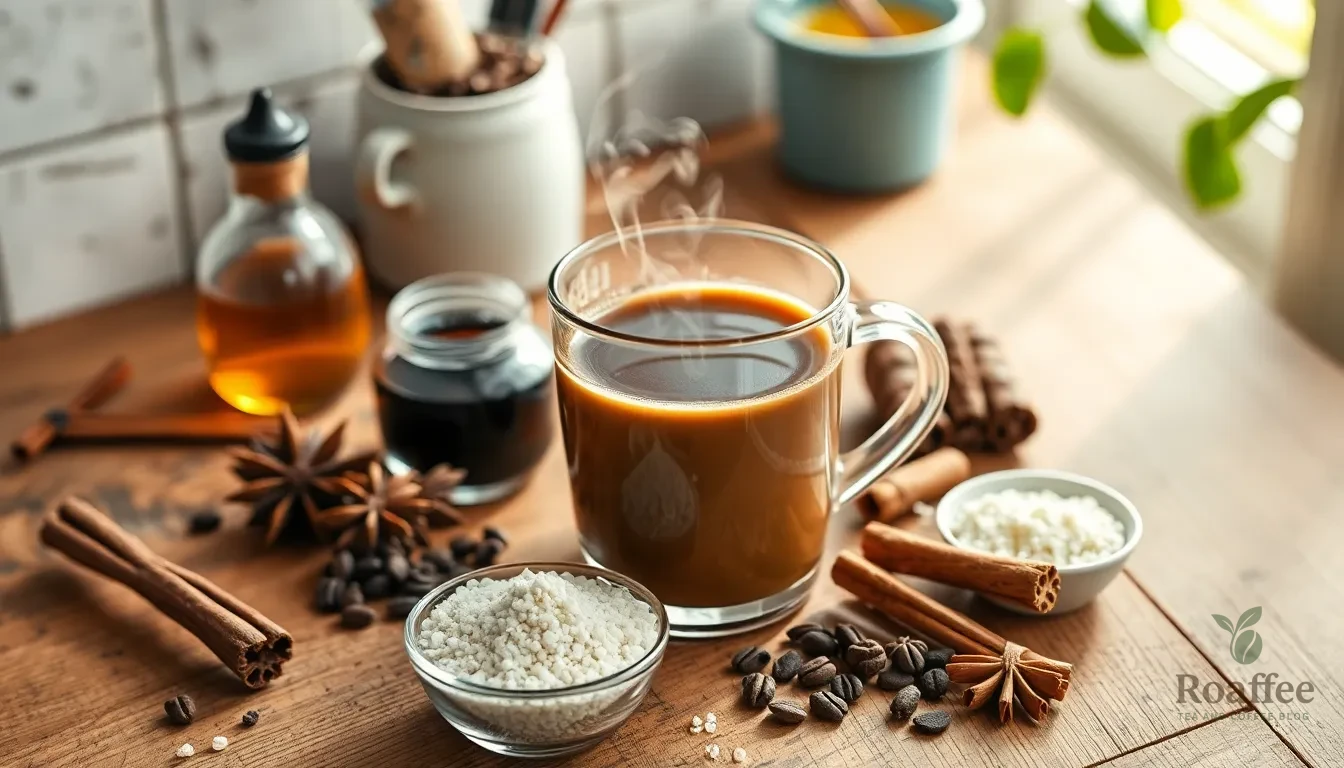
The foundation of great instant coffee lies in selecting the right ingredients and understanding how each element contributes to the final flavor profile. We’ve identified the key components that can transform your instant coffee from ordinary to exceptional.
Quality Instant Coffee Brands
Choosing good quality instant coffee brands with better flavor profiles can improve taste significantly. We recommend looking for brands that use freeze-dried processing rather than spray-dried methods, as these tend to preserve more of the original coffee flavor. Premium instant coffee brands often source their beans from exact regions and maintain better quality control throughout the manufacturing process.
Flavor Enhancement Ingredients
Fresh, filtered water serves as the most crucial ingredient for better instant coffee. We always use filtered water rather than tap or reboiled water to avoid off-flavors that can mask the coffee’s natural taste.
Vanilla extract works as our go-to flavor enhancer. Add a drop of vanilla extract (not syrup) to soften the taste without adding sugar, which can dull flavors. This simple addition creates a smoother, more refined coffee experience.
Spices like cinnamon or cocoa powder add extra flavor and complexity to instant coffee. We sprinkle these directly into the cup before adding water for the best flavor distribution.
Collagen peptides can improve texture and body without affecting flavor. These protein supplements dissolve completely and add a subtle richness to the coffee.
Salt, herbs, or alcoholic shots like Baileys or whiskey can customize flavor for adventurous coffee drinkers. A pinch of salt reduces bitterness, while herbs like cardamom add aromatic complexity.
Milk and Cream Options
Heated milk or creamer improves taste by buffering bitterness. We always warm our milk before adding it to instant coffee, as cold milk can degrade texture and create an unpleasant temperature contrast.
Butter or coconut oil adds richness and removes bitter edges from instant coffee. These fats create a smooth, creamy texture that enhances the overall drinking experience.
Plant-based creamers or homemade creamers provide alternatives to dairy while delivering smoothness and flavor enhancement. We recommend almond, oat, or coconut-based options for the best results.
Whipped cream on top adds sweetness and richness to instant coffee. This finishing touch creates a café-style presentation and adds indulgent flavor without overwhelming the coffee base.
Water Temperature and Quality Tips
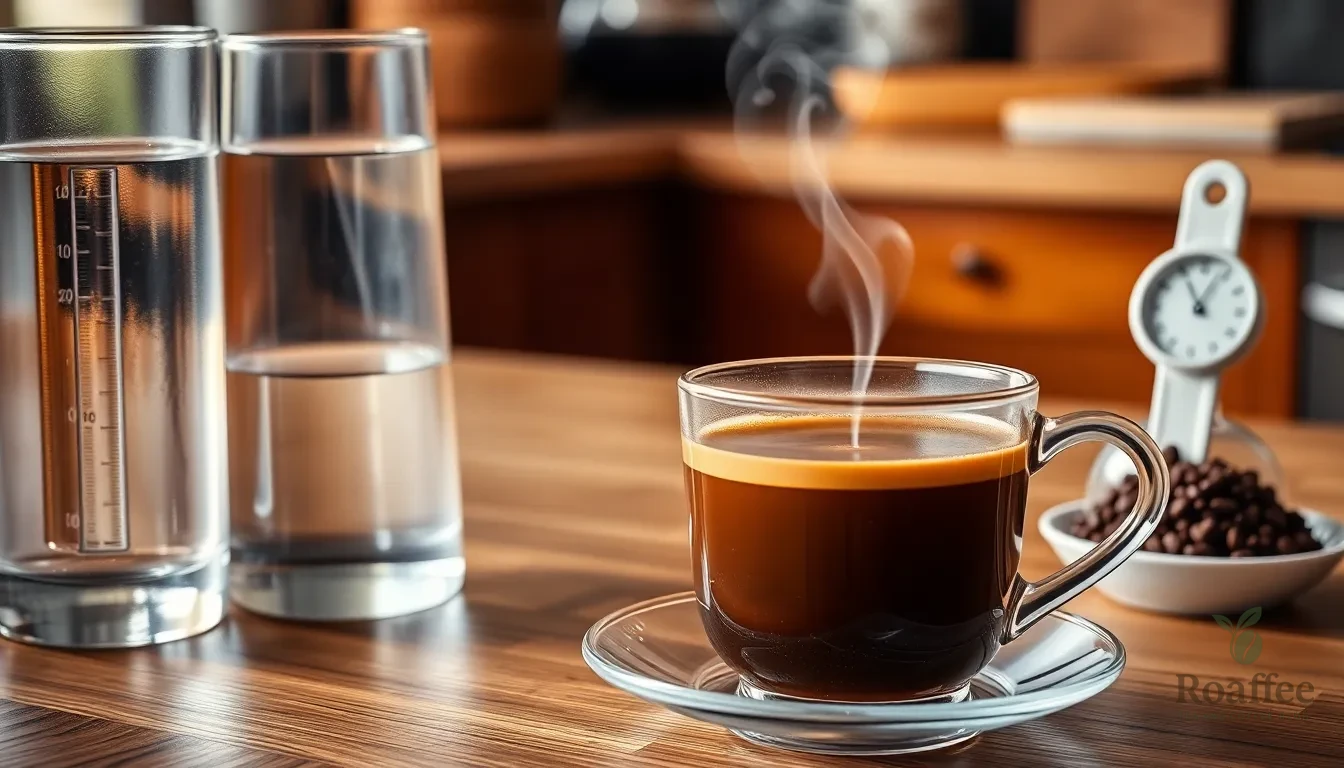
Water temperature and quality serve as the foundation for exceptional instant coffee. These two critical factors can dramatically transform your cup from bitter disappointment to smooth satisfaction.
Optimal Water Temperature
The key to perfect instant coffee lies in achieving the right water temperature range. We recommend heating water to between 190°F and 205°F for optimal extraction and flavor development.
Never pour boiling water directly onto instant coffee granules. This common mistake creates excessive bitterness and burnt flavors that mask the coffee’s subtle characteristics. Instead, boil your water then let it cool for 30 seconds to a minute until it reaches approximately 200°F (93°C).
| Temperature Range | Effect on Coffee |
|---|---|
| 190°F – 205°F | Optimal extraction with balanced flavor |
| 200°F (93°C) | Sweet spot for preserving aromatics |
| Boiling (212°F) | Creates bitterness and burnt taste |
Try the cold water pre-wetting technique for smoother results. First wet the coffee granules with a small amount of cold water to soften the starches. This method reduces chalkiness and bitterness significantly. Then add your hot water to complete the brewing process.
Water closer to 205°F provides better dissolution while maintaining flavor integrity. The temperature allows proper extraction without the harsh bite that boiling water creates.
Water Quality Considerations
Use filtered water whenever possible rather than tap water for instant coffee preparation. Tap water often contains impurities that introduce metallic or acidic flavors that compete with your coffee’s taste profile.
Fresh water makes a noticeable difference in your final cup. Avoid using reboiled or stale water as it diminishes the coffee’s flavor complexity and overall quality.
Consider your water source carefully. Hard water with high mineral content can create a chalky texture while soft water might produce a flat taste. Filtered water provides the neutral base that allows instant coffee’s flavors to shine through clearly.
The quality of your water directly impacts every sip. Clean filtered water ensures that nothing interferes with the coffee’s intended flavor profile while poor quality water can completely overwhelm even premium instant coffee varieties.
Basic Instant Coffee Preparation Method

We’ll transform your instant coffee experience by following these research-backed preparation methods that focus on precise measurements and optimal brewing techniques. These fundamental steps form the foundation for creating a consistently delicious cup every time.
Step-by-Step Brewing Instructions
Start by boiling fresh filtered water in your kettle. While the water heats, measure 1 to 2 teaspoons of instant coffee granules per 240 ml (1 cup) of water into your cup. Adjust this ratio based on your preferred strength.
Allow the boiling water to cool slightly to about 200°F (93°C) before proceeding. This temperature prevents the bitter compounds that develop when boiling water hits coffee granules directly.
Create a small paste by mixing the coffee granules with a teaspoon of cold water first. This cold water pre-dissolving technique softens the granules and reduces bitterness by releasing flavors without extracting harsh compounds.
Pour the hot water over the coffee and cold water mixture gradually. Stir thoroughly to ensure complete dissolution of all granules. We recommend stirring for at least 30 seconds to achieve full extraction.
Taste and adjust the coffee amount or water volume depending on your preferred strength. This final adjustment allows you to customize the intensity to your liking.
Proper Mixing Techniques
Stir thoroughly using a circular motion to dissolve coffee granules completely. Incomplete dissolution leaves gritty residue that affects both texture and flavor distribution.
Mix coffee granules with a small amount of sugar and water to create a paste before adding hot water. This technique enhances flavor by allowing the coffee to bloom properly and creates a smoother base.
Add milk, plant-based creamer, or warm milk instead of plain water for a creamier texture. We substitute up to half the water with your preferred dairy or non-dairy option for richer mouthfeel.
Incorporate flavor boosters like cinnamon, cocoa powder, or a pinch of salt during the mixing process. These ingredients work best when added early so they can fully integrate with the coffee base.
Customize your cup with honey, vanilla extract, or even a splash of Baileys or whiskey for variety. Add these final touches after the coffee has fully dissolved to preserve their distinct flavors.
Flavor Enhancement Techniques
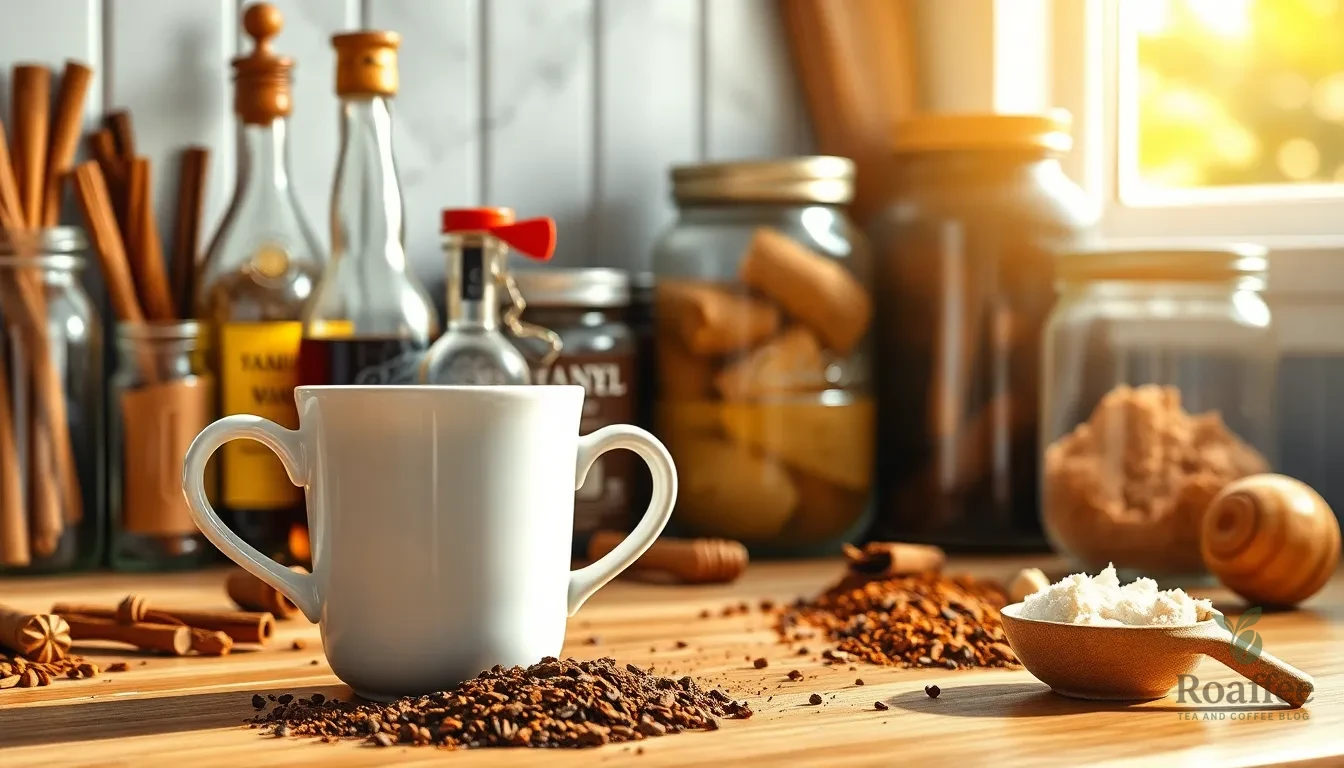
We can transform ordinary instant coffee into a remarkable beverage using simple yet effective flavor enhancement methods. These techniques focus on adding depth and complexity while reducing the common issues that plague instant coffee.
Adding Spices and Extracts
Spices offer an incredible way to elevate instant coffee beyond its basic flavor profile. We recommend sprinkling cinnamon, nutmeg, or cardamom directly into your coffee grounds before adding water. These aromatic spices provide warmth and complexity that masks instant coffee’s artificial notes.
Vanilla extract creates a smooth, sweet undertone that complements coffee’s natural bitterness. A few drops of vanilla syrup or extract can dramatically improve the overall taste experience. Caramel and hazelnut flavored syrups also work exceptionally well for creating coffeehouse-style drinks at home.
Ground cardamom pods add an exotic, slightly floral note that pairs beautifully with coffee’s earthy tones. For best results, we suggest adding spices during the brewing process rather than afterward, allowing them to fully integrate with the coffee.
Sweetening Options
Natural sweeteners provide dual benefits of sweetness and additional flavor complexity. Honey, agave syrup, and maple syrup each contribute their own distinctive taste profiles while reducing instant coffee’s harsh edges. These alternatives dissolve easily and create a more rounded flavor experience than plain sugar.
A pinch of salt might seem counterintuitive, but it effectively counteracts bitterness while improving the coffee’s overall flavor balance. This technique works particularly well with darker roast instant coffees that tend toward excessive bitterness.
Coconut sugar offers a subtle caramel-like sweetness that complements coffee naturally. Brown sugar works similarly, providing depth that white sugar cannot match. We find that liquid sweeteners integrate more smoothly than granulated options, creating a more uniform taste throughout the cup.
Creating Coffee Blends
Blending instant coffee with small amounts of freshly brewed coffee or espresso creates remarkable depth and complexity. This technique allows us to maintain convenience while adding the nuanced flavors that instant coffee typically lacks.
Milk and cream additions transform instant coffee’s texture and mouthfeel significantly. Almond, oat, and coconut milk each bring their own subtle flavors while creating a smoother, more luxurious drinking experience. These dairy alternatives work particularly well for those seeking plant-based options.
Combining different instant coffee brands can create custom flavor profiles customized to personal preferences. We suggest mixing a darker roast instant coffee with a lighter variety to achieve balanced acidity and body. This approach allows for experimentation without investing in expensive equipment or beans.
Milk and Cream Additions
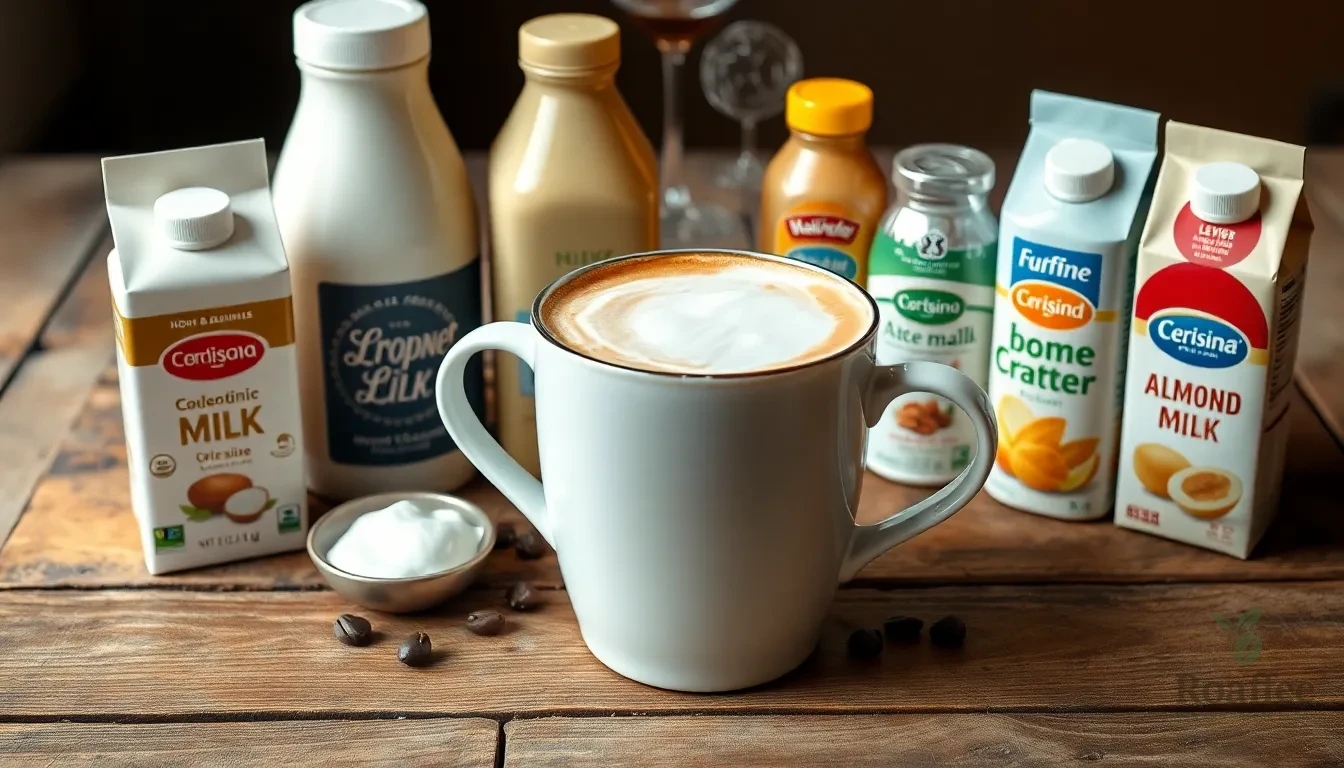
Adding milk or cream to instant coffee significantly improves its texture and flavor by smoothing bitterness and adding richness. We’ll explore the best techniques for incorporating dairy and non-dairy options to transform your instant coffee experience.
Hot Milk Techniques
Heat milk to about 150°F (65°C) before mixing with instant coffee for optimal results. This temperature creates a smooth, velvety texture without scalding the milk or compromising its natural sweetness. We recommend using a kitchen thermometer to achieve precision, as this exact temperature preserves the milk’s proteins while ensuring proper integration with the coffee.
Avoid boiling milk as it can alter flavor negatively and affect frothing quality. Instead, warm the milk gently on the stovetop or in the microwave, stirring occasionally to prevent skin formation. The heated milk should feel comfortably warm to the touch but not burning hot.
Pour the warmed milk slowly into your prepared instant coffee, allowing the temperatures to blend gradually. This technique creates a café-style drink with enhanced creaminess and reduced bitterness compared to adding cold milk directly.
Frothing Methods
Use a milk frother or French press to froth hot milk, creating creamy microfoam that elevates instant coffee into a latte-like drink. Pour cold milk less than halfway into a pitcher, then heat to 150°F before beginning the frothing process.
Position the frother wand just below the surface of the heated milk to create whirlpool action. Move the wand in circular motions until the milk doubles in volume with fine, silky foam. This technique produces the ideal texture for layering over instant coffee.
French press frothing offers an alternative method for those without electric frothers. Heat milk to the proper temperature, pour into the French press, and pump the plunger rapidly for 30-60 seconds until the milk becomes light and foamy.
The frothed milk adds pleasant texture, improved mouthfeel, and aesthetic appeal to instant coffee drinks. We find this method particularly effective for creating specialty coffee drinks at home without expensive equipment.
Non-Dairy Alternatives
Non-dairy creamers provide excellent options for those avoiding dairy while still wanting creamy texture and enhanced taste. Flavored creamers such as vanilla, hazelnut, caramel, or peppermint offer extra flavor variety, making them ideal for customization without needing additional syrups or sweeteners.
Oat milk froths exceptionally well due to its natural proteins and creates a rich, creamy texture similar to dairy milk. Coconut milk adds tropical notes and natural sweetness, while almond milk provides a lighter texture with subtle nutty undertones.
Soy milk remains a reliable choice for frothing and blends seamlessly with instant coffee without overpowering its flavor. Cashew cream offers the richest texture among plant-based options, creating an indulgent coffee experience.
We suggest experimenting with different non-dairy alternatives to discover your preferred flavor profile. Each option brings unique characteristics that can complement or enhance the instant coffee base in distinct ways.
Advanced Flavor Combinations

When we want to transform instant coffee into a truly exceptional beverage, combining complementary flavors opens up endless possibilities. These sophisticated combinations leverage exact ingredients and techniques to create complex, café-quality drinks that rival traditional brewing methods.
Chocolate and Mocha Variations
We can easily create rich mocha-flavored instant coffee by mixing chocolate syrup directly with coffee granules before adding hot water. This technique allows the chocolate to dissolve completely while infusing the coffee with deep cocoa notes. Adding warm milk instead of plain water creates an even creamier base that enhances the chocolate’s richness.
For an indulgent café-style experience, we recommend topping the mocha with whipped cream and a drizzle of caramel or toffee bits. The NESCAFÉ French Vanilla Mocha approach combines instant coffee with chocolate syrup and French vanilla creamer, then garnishes with whipped cream for a luxurious finish. This combination creates multiple flavor layers that mask any artificial notes while delivering a dessert-like beverage perfect for afternoon treats.
Spiced Coffee Recipes
Warming spices transform ordinary instant coffee into an aromatic, complex beverage that engages multiple senses. We achieve the best results by infusing milk with cinnamon, nutmeg, or cardamom before mixing it with coffee granules. This technique allows the spices to bloom in the heated milk, releasing their essential oils and creating deeper flavor integration.
Beyond traditional warming spices, we can experiment with unique additions like a pinch of salt to counteract bitterness, or fresh herbs for unexpected taste dimensions. The key lies in adding spices during the brewing process rather than as an afterthought, allowing them to fully dissolve and distribute throughout the drink. These spiced variations work particularly well during colder months when we crave comfort beverages with warming properties.
Vanilla and Caramel Options
Vanilla and caramel syrups offer the perfect balance of sweetness and flavor complexity when combined with instant coffee and hot water. We control the sweetness level by adjusting syrup quantities according to personal preference, typically starting with one teaspoon and building from there. These syrups create smooth, dessert-like beverages that feel indulgent without being overpowering.
The combination of vanilla or caramel with milk creates particularly satisfying results, as the dairy amplifies the sweet notes while adding creamy texture. We can elevate this combination further by adding whipped cream and an additional caramel drizzle, creating a beverage that rivals expensive coffeehouse drinks. These flavored options work exceptionally well for evening coffee when we want something that feels more like a treat than a caffeine boost.
Make-Ahead Tips
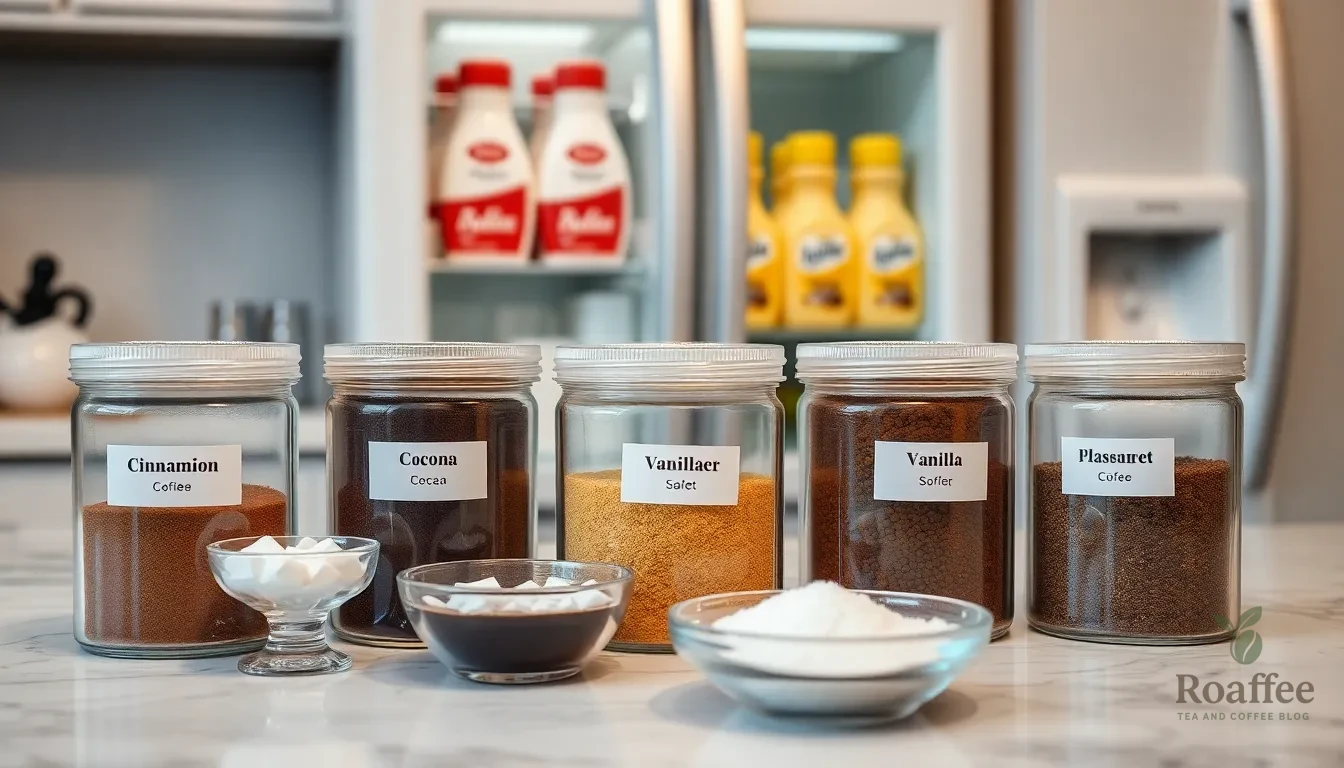
We can streamline our morning coffee routine by preparing flavor combinations and implementing proper storage techniques ahead of time. These preparation methods save time while ensuring consistent taste quality every cup.
Pre-Mixed Flavor Combinations
We recommend creating pre-mixed coffee combinations that dissolve smoothly and deliver enhanced flavor profiles. Start by combining instant coffee granules with complementary dry ingredients like cinnamon powder, cocoa powder, or powdered vanilla extract in sealed containers. These dry mixes allow us to scoop and brew without measuring multiple ingredients each time.
Our most successful pre-mixed combinations include:
- Vanilla Coffee Mix: Blend 1 cup instant coffee granules with 1 teaspoon pure vanilla extract powder
- Spiced Coffee Blend: Combine instant coffee with equal parts cinnamon and nutmeg powder
- Mocha Coffee Mix: Mix coffee granules with unsweetened cocoa powder in a 3:1 ratio
Store these pre-mixed combinations in airtight containers labeled with ratios and brewing instructions. We find that adding a small amount of salt to each mixture helps reduce bitterness while improving overall flavor complexity.
For liquid additions, we prepare flavored creamers by combining milk with vanilla extract, honey, or cinnamon syrup in advance. These prepared creamers stay fresh in the refrigerator for up to one week and instantly transform basic instant coffee into a café-quality beverage.
Storage Answers
Proper storage techniques preserve instant coffee flavor and prevent staleness that degrades taste quality. We store opened instant coffee containers in airtight glass jars or sealed plastic containers to prevent moisture exposure and oxidation. The original packaging often lacks sufficient sealing once opened, making transfer to better containers essential.
| Storage Method | Shelf Life | Quality Impact |
|---|---|---|
| Original packaging (opened) | 2-3 months | Flavor degrades quickly |
| Airtight container | 6-12 months | Maintains flavor integrity |
| Freezer storage | 12-18 months | Best long-term preservation |
We keep stored instant coffee in cool, dry locations away from direct sunlight and heat sources. Kitchen cabinets work well, but avoid areas near stoves or windows where temperature fluctuations occur. For long-term storage, we portion instant coffee into smaller containers to minimize air exposure when accessing our supply.
Bulk purchasing during sales allows us to stock quality freeze-dried varieties at better prices. We divide large quantities into weekly portions using small airtight containers, keeping the bulk supply sealed until needed. This approach maintains freshness while taking advantage of cost savings on premium instant coffee brands.
Troubleshooting Common Issues
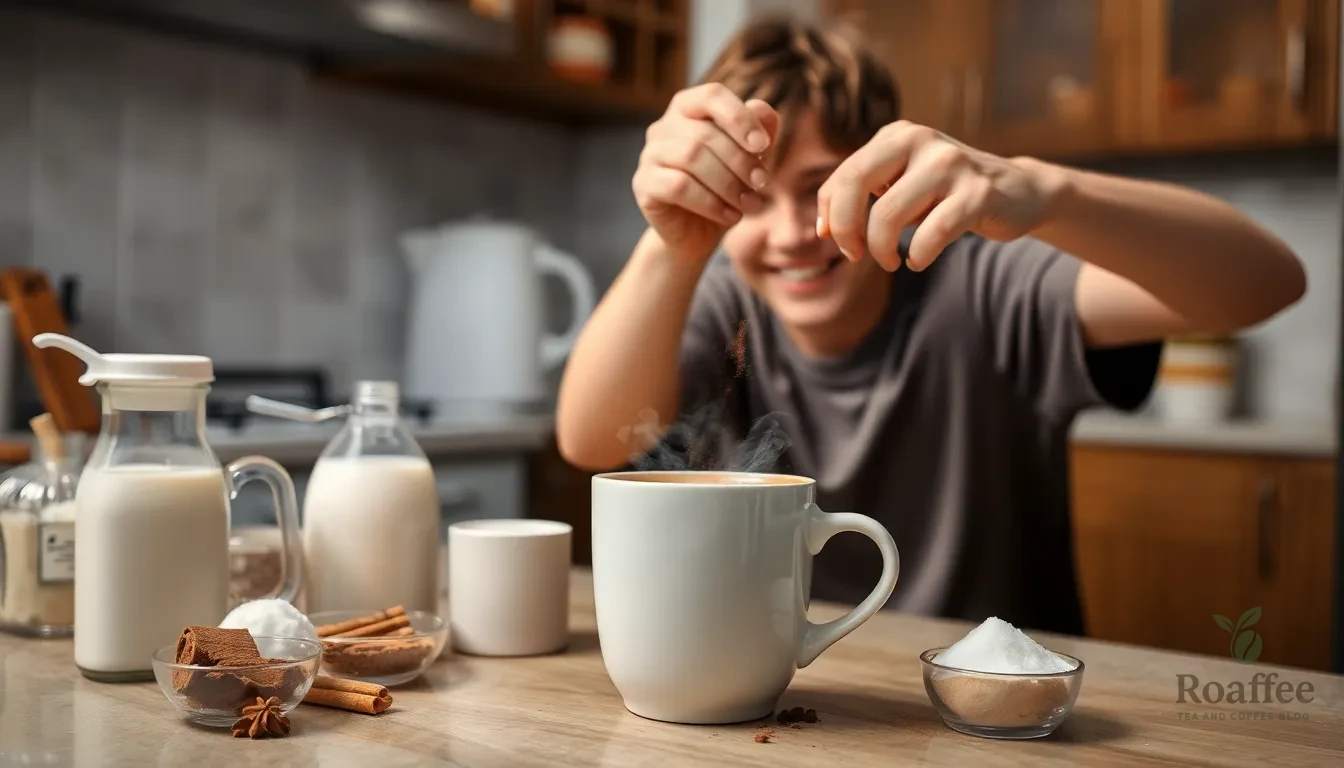
Even with the best preparation techniques, instant coffee can still present challenges like bitter or weak flavors. We’ll address these common problems with proven answers that transform your coffee experience.
Fixing Bitter Coffee
Use Cold Water First: We recommend dissolving instant coffee granules in a small amount of cold water before adding hot water. This method reduces bitterness by preventing the hot water from extracting bitter compounds immediately.
Optimal Water Temperature: Avoid boiling water when brewing instant coffee. Let freshly boiled water cool for 30 seconds to 1 minute to about 200°F (93°C). This temperature dissolves coffee effectively without creating a burnt or overly bitter taste.
Adjust Grind and Brew Factors: For brewed coffee, bitterness often comes from over-extraction due to fine grind or long brew times. Although this applies more to brewed coffee than instant, shorter brew times or coarser grinds reduce bitterness in regular coffee preparation.
Dealing with Weak Flavor
Increase Coffee Quantity: Use more instant coffee—try two teaspoons instead of one—to boost richness and flavor. This technique works especially well with lower-grade brands that may have reduced coffee solids.
Make a Coffee Paste: Mix instant coffee with a bit of sugar and a little cold water to form a paste before adding hot water. This technique encourages a richer crema and fuller flavor while reducing weak taste.
Add Flavor Enhancers: Incorporate milk, creamers, sugar, spices like cinnamon, cocoa powder, or even a pinch of salt to improve taste and add complexity. These additions work together to create a more robust and satisfying coffee experience.
Experiment with Water Ratios: Adjust your coffee-to-water ratios to achieve your preferred intensity. Start with our recommended measurements and gradually increase the coffee amount until you reach your ideal strength.
Try Flavor Boosters: Butter or honey can add smoothness and sweetness to weak coffee. For adult beverages, alcohol like Baileys or whiskey creates unique flavor profiles that mask weakness while adding depth.
Conclusion
We’ve shown you that transforming instant coffee from bland to brilliant doesn’t require expensive equipment or exotic ingredients. With simple techniques like proper water temperature control cold water pre-dissolving and strategic flavor additions you can create a satisfying cup that rivals more expensive alternatives.
The key lies in understanding the fundamentals: quality ingredients precise measurements and proper storage techniques. Whether you’re adding warming spices creating make-ahead blends or troubleshooting common issues these methods will consistently deliver better results.
Now you’re equipped with the knowledge to elevate every cup of instant coffee you brew. Start with one or two techniques that appeal to you most and gradually experiment with different combinations to find your perfect flavor profile.
Frequently Asked Questions
What’s the best water temperature for making instant coffee?
The optimal water temperature for instant coffee is between 190°F to 205°F. Avoid pouring boiling water directly onto coffee granules as this can create bitterness. Let boiling water cool for about 30 seconds before mixing. Using a thermometer helps achieve consistent results, but you can also judge by waiting until the water stops bubbling vigorously.
How can I reduce the bitterness in instant coffee?
To reduce bitterness, try pre-dissolving coffee granules in a small amount of cold water before adding hot water. This technique softens the granules and prevents over-extraction. Additionally, add a pinch of salt to neutralize bitter compounds, use filtered water, and avoid water that’s too hot. Quality freeze-dried brands also tend to be less bitter.
What ingredients can enhance the flavor of instant coffee?
Common flavor enhancers include spices like cinnamon, nutmeg, and cardamom, which add complexity and mask artificial notes. Sweeteners like honey, agave syrup, or coconut sugar provide unique flavor profiles. Vanilla extract, cocoa powder, and even a small amount of butter or coconut oil can create richness and depth in your instant coffee.
Should I use filtered water for instant coffee?
Yes, filtered water significantly improves instant coffee taste. Tap water often contains chlorine, minerals, and impurities that can create off-flavors and interfere with the coffee’s natural taste. Filtered water provides a clean base that allows the coffee’s intended flavors to shine through, making even budget instant coffee taste noticeably better.
How do I store instant coffee to maintain freshness?
Store instant coffee in an airtight container in a cool, dry place away from direct sunlight. Avoid storing it in the refrigerator or freezer, as moisture can cause clumping and flavor degradation. Keep the container tightly sealed after each use, and consider transferring coffee from opened jars to smaller containers to minimize air exposure.
What’s the proper coffee-to-water ratio for instant coffee?
Start with 1 to 2 teaspoons of instant coffee per 6-8 ounces of water, then adjust to taste. For stronger coffee, increase the coffee amount rather than decreasing water, as this maintains proper extraction. Measuring spoons ensure consistency, and you can experiment with ratios to find your preferred strength without creating bitterness.
Can I mix instant coffee with regular brewed coffee?
Yes, blending instant coffee with freshly brewed coffee or espresso adds depth and complexity. Use instant coffee as a base and add a small amount of fresh coffee for enhanced flavor. This technique is particularly useful when you want stronger coffee without the bitterness that comes from using too much instant coffee alone.
What are some make-ahead tips for instant coffee?
Create pre-mixed flavor combinations by blending instant coffee with spices, sweeteners, and flavor enhancers in airtight containers. Popular mixes include vanilla-cinnamon blends and mocha combinations with cocoa powder. Store these mixtures in small containers for quick morning preparation. Label containers with ratios and expiration dates for best results.
















